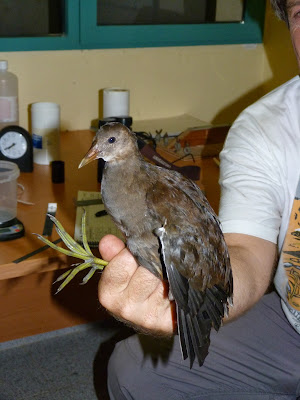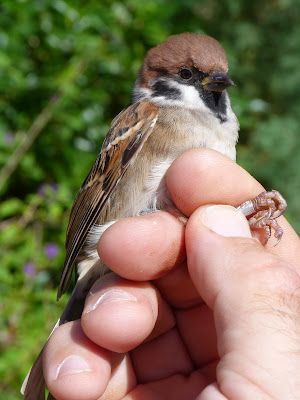Against all odds we made it onto the plane and have arrived at the Canal Vell site of the Parc Natural del Delta de L'Ebre. The drive from Barcelona Airport was straight forward but the last couple of miles was not so. After eventually calling Sergio Hernandez, our contact who was to show us the rides and required data, it transpired that we had driven past the access road twice. We could not convey exactly where we were or he were we should go, so arranged to met at Lidl's which we all knew the location of. Sadly the entrance was all but invisible in the dark with the information board a good distance up the track so no wonder that we missed it. We arrived well after midnight and were shown to our bunk room. There was another married couple staying - him being a late starter trainee - making for a very snug situation in 'La petita casa'.
Living area
Compact bunk room ( 2 of these in the casa)
Tiddly kitchen - so glad it was just the two of us most of the time
During the first day we acquainted ourselves with the locale, making
use of the tower viewing platform right outside our door. We could see
thousands of birds including over hundred Snipe, probably around a thousand
Glossy Ibis, and endless numbers of Grey Heron, Litte and Great Egrets, odd
groups of Cattle Egrets and Gulls, mainly several thousand Black-headed either
in the surrounding paddy fields, on the lake or passing over head. During the
visit, it was not the variety of birds seen, being outside the summer migrant
period, but the sheer numbers of the birds on the rice fileds as the rice
was harvested or the reploughing of the fields. At dawn or dusk the number of
birds in the air to and from roosts was always a spectactular sight,
especially as the Ibis roosted just next to the centre.
Observation tower
Churning up the paddy field attracted much attention from the birds
Glossies gathering at dusk
Unfortuntaely we arrived on the first weekend of the hunting season, so the number birds in the air over the weekend were higher as the shots from the hunters rang out. The most commonly taken birds are Coot and Mallard but other species are also on the list. One of our ringed Song Thurshes and an unringed Moorhen appeared at the Centre entrance at some stage, dead and one day we found a young Moorhan with wing damage and its leg virtually hanging on by a few tendons, that had to be brought to the rehab centre. We are not anti-hunting persa, but the birds' non fatal injuries are the unacceptible side of it.
After a morning of firing at various birds these hunters head off home with their dogs and loot from the shoot.
Site observation and rehab centre
The observation centre adjoins an infirmary where birds with various injuries are brought in. There is an avairy which contained a few Greater Flamingos, with Audouin's Gulls, single Great White Egret and Lesser Black-becked Gull, and a Ruddy Shelduck from somewhere. During the stay a Wood Pigeon was brought in as a shooting casualty, a Purple Gallinulle (brought in for tagging and relocation) and a Flamingo was released within out first few days. Two other resident neighbours were Boris (our given name for him (or her) the Griffon Vulture and a rather bad tempered Eagle Owl, both with only one wing. It seemed unfair to subject such birds to an existence in a small enclosure being offered only pre-killed meals, although the odd Cetti's Warbler that dived for the cover of conifers, growing within the cage confines, before moving on safely after release did provide some interest and relieve their monotony.
For anyone not entirely certain - the idea is that birds with some sort of injury ( e.g., as above).......
are patched up and returned to the wild.
But this Griffon Vulture had a wing amputated and could not be released. He/she also disposed of some of the bodies of those individuals beyond help.
Eagle Owl
The temperature started off in the mid 20s, certainly very comfortable
for the many mosquitoes that inhabit the area. There were large numbers of
dragonfly and a lot of Red Admiral and a sighting of a Plain tiger over a few days.
Plain Tiger on a ripe fig
The first couple of days ringing was shared with Vincente guided by
Sergio, before we were left at the station on our own.
The arranged start for Saturday was at 8am, made more leisurely as the
nets are opened daily in early evening then closed around abouts 2pm the
following day, meaning that nets remain open all night. Unfortunately the key
had gone missing and it became necesary to force the door to the ringing room
as there were birds in there to be released, while the nets needed checking and
we needed bird bags, having already released a few birds at the net. Later we
were given the experience of watching Spanish 'make do and mend' in action as
the door and lock were reassembled and reconstructed with 'glue, clamps, nails
and a very useful hammer' and to our astonishment, the door would shut and the key still turned in the
lock, Sergio having later re-found the
key on the floor outside the supermarket where he met us the night before.
Vicente and Sergio demonstrate some useful obs skills not covered under the BTO competencies
Saturday was fairly quiet with only eighteen birds, the most notable being a
re-trapped Great Reed Wartbler, a Reed Warbler and three Bluethroats caught
after nightfull. Birdwise, on El Canal Vell there were Black-necked Grebe,
Wigeon, Teal, Red-crested Pochards and a single Flamingo, with an Audioun's
Gull on the top of one of the rehabilitation cages, four Little Stints and Wood
Sandpipers on the adjacent rice fields, along with extraordinary numbers of
Black-headed Gull, Great and Little Egrets, Grey Herons, Glossy Ibis and
Starlings, with Yellow-legged and Lesser Black-backed Gulls in support.
Juvenile Moorhen
Bluethroat- white spotted form
The next day's ringing was slightly better with 27 birds, with another two
Bluethroats (at dusk again), two Reed Warblers, a single Fan-tailed Warbler and
two Tree Sparrows. Birdwise the adjacent lake held
a couple of Sandwich Terns, a group of Pochard first thing, and seven Night
Herons were put up by the shooting. At lunch a Booted Eagle was overhead while
we ate at the Grazia Restaurant (menues with pictures - great for those who
don't speak Spanish or Catalan). It was also a bit of a butterfly day with the
Plain Tiger, from North Africa, along one of the ringing rides, with Clouded
Yellow, Speckled Wood Painted Lady seen, with as Gernanuim Bronze, on the pot plants (of
course).
Tree Sparrow
Geranium Bronze
Speckled Wood
Monday again saw catch numbers increasing to 32 with a further two
Bluethroats, three Reed Warblers, and another three Tree Sparrows. Birdingwise
there were three Swallows, a group of Serins outside the Centre, a fly over
Gull-billed Tern, the first Black Redstart, the fore runner of an influx, and
Spotless Starlings, only a few isolated from the 1000s of the spangled variety.
A Crested Lark was seen at the nearby Platja de la Marquesa.
Bluethroat female
Black Redstart
Extensive Starling flocks feed in the rice paddies






















